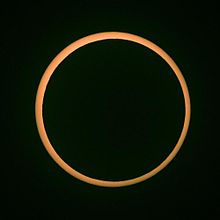- Magnitude of eclipse
-
Not to be confused with apparent magnitude, the logarithmic scale of astronomical brightness.
The magnitude of eclipse or geometric magnitude is the fraction of the diameter of the eclipsed body which is in eclipse. This applies to both solar eclipses and lunar eclipses. During a partial or annular eclipse the magnitude of the eclipse is always between 0.0 and 1.0, while during a total eclipse the magnitude is always at least 1.0. If the magnitude is less than 0.0 there is no eclipse.
Technically, the magnitude is computed as such: draw a straight line between the centers of the eclipsed body and the eclipsing body (or shadow). Find out how large a fraction of this line within the eclipsed body is in eclipse; this is the geometric magnitude of the eclipse. If the eclipse is total, one can extend this line in one direction to the nearest limb of the eclipsing body (or shadow) and obtain a geometric magnitude larger than 1.0. If there is no eclipse but a near miss, one can also extend the line towards the nearest limb of the eclipsing body (or shadow), counting this distance as negative, and obtain a negative geometric magnitude.
This measure should not be confused with the astronomical magnitude logarithmic scale of brightness. It should neither be confused with the obscuration of the eclipse, which is the fractional area which is eclipsed.
Contents
Effect of the magnitude on a solar eclipse
In an annular solar eclipse, the magnitude of the eclipse is the ratio between the apparent angular diameters of the Moon and that of the Sun during the eclipse, yielding a ratio less than 1.0.
In a total solar eclipse which also is a central eclipse, the magnitude is also the ratio between the apparent diameters of the Moon and of the Sun, but this time the ratio is 1.0 or bigger. If the total solar eclipse is non-central, the magnitude is a number between 1.0 and this ratio of apparent diameters.
In a partial solar eclipse, the magnitude of the eclipse is the fraction of the Sun's diameter occulted by the Moon at the time of maximum eclipse.[1] The Moon's and Sun's apparent sizes are approximately the same, but both vary because the distance between Earth and Moon varies. (The distance between Earth and Sun also varies, but the effect is slight in comparison.)
When the magnitude of the eclipse is larger than one, the Moon's disk will completely cover the Sun's disk in the sky, and so the eclipse will be total. The path of totality (i.e. of the travelling shadow of the Moon cutting off all sunlight from reaching the Earth's surface) is a relatively narrow strip, at most a few hundreds of kilometers across.
When the magnitude of the eclipse is less than one, the disk of the Moon cannot completely cover the Sun. When the centers of the two disks are sufficiently aligned, a ring of sunlight remains visible around the Moon. This is called an annular eclipse, from Latin annulus, meaning "ring".[2]
The eclipse magnitude varies not only between eclipses, but also during a given eclipse. It may happen that an eclipse starts out as annular, and then becomes total. The reverse is also possible. In very rare cases, the eclipse may proceed from annular, via total, back to annular. These mixed-type eclipses are called hybrid.[2]
Also, as seen from one location, the momentary eclipse magnitude varies, being exactly 0.0 at the start of the eclipse, rising to some maximum value, and then decreasing to 0.0 at the end of the eclipse. When one says "the magnitude of the eclipse" without further specification, one usually means the maximum value of the magnitude of the eclipse.
Effect of the magnitude on a lunar eclipse
The effect on a lunar eclipse is quite similar, with a few differences. First, the eclipsed body is the Moon and the eclipsing 'body' is the Earth's shadow during a lunar eclipse. Second, since the Earth's shadow at the Moon's distance always is considerably larger than the Moon, a lunar eclipse can never be annular but is always partial or total. Third, the Earth's shadow has two components: the dark umbra and the much brighter penumbra. A lunar eclipse will have two geometric magnitudes: the umbral magnitude and the penumbral magnitude. If the maximum value of the umbral magnitude is negative, the Moon doesn't reach into the Earth's umbra - it may still pass through the Earth's penumbra though, and such an eclipse is called a penumbral eclipse.
See also
References
- ^ "Glossary of Solar Eclipse Terms". NASA. http://eclipses.gsfc.nasa.gov/SEhelp/SEglossary.html. Retrieved 2009-07-27.
- ^ a b Erickson, Robbi (2008). "Happy Living Magazine - Solar eclipse viewing schedule and information". Happy Living Magazine. http://www.happynews.com/living/space/solar-eclipse-viewing.htm. Retrieved 2009-07-27.
External links
Categories:- Eclipses
Wikimedia Foundation. 2010.

